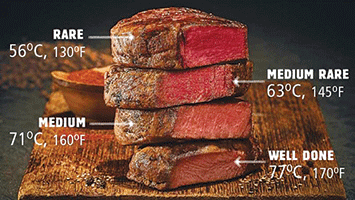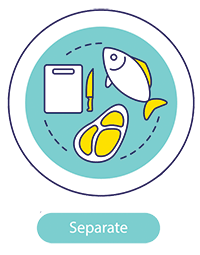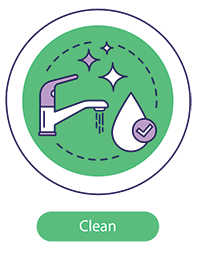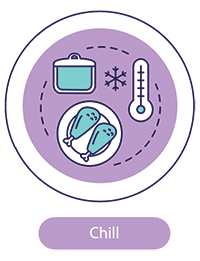Rare or well-done: A guide to healthy grilling
 It’s grilling time again. Some folks like their meat rare, others like it well done. What is the safest temperature? Here’s the beef on how to grill the right way so you can enjoy cookouts without having to worry.
It’s grilling time again. Some folks like their meat rare, others like it well done. What is the safest temperature? Here’s the beef on how to grill the right way so you can enjoy cookouts without having to worry.
Each year, 48 million Americans are diagnosed with food poisoning, often from eating undercooked meat, poultry and other animal products. Bacteria such as E. coli and salmonella are regular residents in chicken, beef and meats. If you don’t cook meat to a high enough temperature to kill the bacteria or other germs, they can wind up in the intestinal tract and lead to symptoms like vomiting, stomach cramps and diarrhea.
If you’re doing your own grilling, here are some tips to avoid foodborne illness. These are minimum temperature requirements, so it’s OK to cook your meat a little longer if you prefer it more well done.
- Ground beef must be heated throughout to a temperature of 160 degrees Fahrenheit.
- Steaks, roasts and pork should be heated to 145 degrees Fahrenheit.
- Poultry should be heated to 165 degrees Fahrenheit.
- Beef, veal, lamb and pork should also be allowed to rest three minutes after cooking before being served. During the rest time, the temperature of the meat will remain constant or continue to rise, which will destroy harmful germs.
HOW YOU CAN TELL WHEN MEAT IS DONE
Unfortunately, you can’t tell whether meat is safely cooked just by looking at it. Any cooked, uncured red meats – including pork – can be pink, even when the meat has reached a safe internal temperature. A safely cooked hamburger patty may look brown, pink or some variation of brown or pink.
The only fail-safe method for determining whether or not meat is done is to check its internal temperature using a meat thermometer.
Of course, you can’t do that in a restaurant. Restaurants use varying guidelines to determine what temperatures constitute rare, medium rare, medium, etc. But in most cases, if you order steaks to be cooked at least to medium and burgers to well done, they will likely meet the minimum temperature requirements.
OVERCOOKING MEAT IS BAD, TOO
Turns out, undercooked meat isn’t the only hazard. Meats cooked at a very high temperature can also cause problems. Researchers have found that high consumption of well-done, fried or barbecued meats is associated with an increased risk of colorectal, pancreatic or prostate cancer.
When beef, pork, fish or poultry is cooked using high-temperature methods, such as pan frying or grilling directly over an open flame, they form chemicals known as heterocyclic amines (HCAs) and polycyclic aromatic hydrocarbons (PAHs). HCAs and PAHs cause changes in DNA that may increase your risk of cancer.
Meats cooked at high temperatures, especially above 300 degrees Fahrenheit (as in grilling or pan frying) or that are cooked for a long time, tend to form more HCAs. For example, well done, grilled or barbecued chicken and steak all have high concentrations of HCAs. Cooking methods that expose meat to smoke or charring contribute to PAH formation.
According to the National Cancer Institute, there are several methods for reducing your risk of exposure to HCAs/PAHs, including:
- Avoid prolonged cooking times (especially at high temperatures).
- Use a microwave oven to cook meat prior to exposure to high temperatures to reduce the time the meat must be in contact with high heat to finish cooking.
- Continuously turn meat over on a high heat source as opposed to just leaving the meat on the heat source without frequent flipping.
- Remove charred portions of meat.
- Do not make gravy from meat drippings.
When it comes to cooking or ordering meat in a restaurant, keep these tips in mind to lower the risk of food-borne illness or exposure to HCAs.
Food prep safety tips
 Preventing food poisoning starts in the preparation. Follow these food safety tips to ensure that grilled meat doesn’t make you sick:
Preventing food poisoning starts in the preparation. Follow these food safety tips to ensure that grilled meat doesn’t make you sick:
• Separate food. Keep raw meat away from fruits, vegetables, and any other foods you’re going to eat without cooking, to avoid bacterial cross-contamination. Cut raw meats on a different surface than other foods. Then wash every cutting board, plate and utensil the raw meat touched with hot water and soap. Always use new serving plates and utensils for cooked food.

 • Clean up. Wash hands with warm water and soap for at least 20 seconds before preparing food and after handling raw meat. Ask the same of anyone else who is going to be handling food.
• Clean up. Wash hands with warm water and soap for at least 20 seconds before preparing food and after handling raw meat. Ask the same of anyone else who is going to be handling food.
• Keep it cold. Store meat and poultry in the refrigerator until you’re ready to grill it. If you have any meat left over from grilling, either keep it warm (140 F or hotter) or put it in the fridge within two hours (within one hour if the temperature outside is over 90 F). Freeze any ground meat or poultry that you don’t use within one to two days.



Leave a Reply